![The organometallic anticancer complex [(η6-p-cymene)Ru(en)Cl]PF6](http://pubs.rsc.org/services/images/RSCpubs.ePlatform.Service.FreeContent.ImageService.svc/ImageService/image/GA?id=C1DT11189B) Peter Sadler from Warwick University, and collaborators at the Chinese Academy of Sciences have developed a ruthenium arene anticancer complex that inhibits the action of protein tyrosine phosphatase 1B, which regulates insulin levels.
Peter Sadler from Warwick University, and collaborators at the Chinese Academy of Sciences have developed a ruthenium arene anticancer complex that inhibits the action of protein tyrosine phosphatase 1B, which regulates insulin levels.
In this Dalton Transactions Hot article the team investigate how the complex interacts with the active site of PTP1B by using a similiar shaped molecule as a model. Their compound was found to have an IC50 of 19 μM.
Read the full article for FREE until 2nd November to find out more about how this anticancer compound works…
Reactions of an organoruthenium anticancer complex with 2-mercaptobenzanilide—a model for the active-site cysteine of protein tyrosine phosphatase 1B
Yumiao Han, Qun Luo, Xiang Hao, Xianchan Li, Fuyi Wang, Wenbing Hu, Kui Wu, Shuang Lü and Peter J. Sadler
Dalton Trans., 2011, DOI: 10.1039/C1DT11189B
Keep up to date with the latest news and research in inorganic chemistry: sign up to the Dalton Transactions e-alert, check out our blog, and follow us on Twitter.
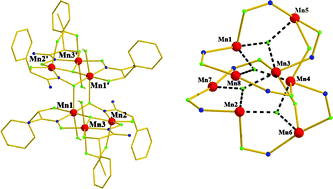











![The organometallic anticancer complex [(η6-p-cymene)Ru(en)Cl]PF6](http://pubs.rsc.org/services/images/RSCpubs.ePlatform.Service.FreeContent.ImageService.svc/ImageService/image/GA?id=C1DT11189B) Peter Sadler from Warwick University, and collaborators at the Chinese Academy of Sciences have developed a ruthenium arene anticancer complex that inhibits the action of protein tyrosine phosphatase 1B, which regulates insulin levels.
Peter Sadler from Warwick University, and collaborators at the Chinese Academy of Sciences have developed a ruthenium arene anticancer complex that inhibits the action of protein tyrosine phosphatase 1B, which regulates insulin levels.

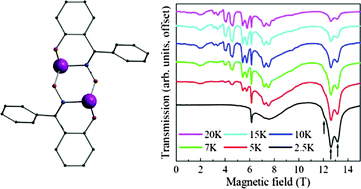 In this HOT Article, the serendipitous self-assembly of the complex [MnIII2ZnII2(Ph-sao)2(Ph-saoH)4(hmp)2], whose magnetic core consists solely of two symmetry equivalent Mn(III) ions linked by two symmetry equivalent –N–O– moieties, provided Brechin and co-workers with a relatively simple model complex with which to study the magneto-structural relationships in more complicated polynuclear oxime-bridged Mn(III) cluster compounds.
In this HOT Article, the serendipitous self-assembly of the complex [MnIII2ZnII2(Ph-sao)2(Ph-saoH)4(hmp)2], whose magnetic core consists solely of two symmetry equivalent Mn(III) ions linked by two symmetry equivalent –N–O– moieties, provided Brechin and co-workers with a relatively simple model complex with which to study the magneto-structural relationships in more complicated polynuclear oxime-bridged Mn(III) cluster compounds.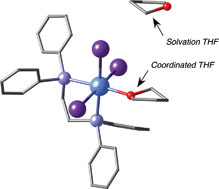 In this HOT article, Díaz-Torres and Alvarez have developed a scale which attempts to quantify the weakly coordinating character of a variety of solvents and anions towards a transition metal or a lanthanide. This was made possible by analyzing crystal structures for the presence of coordinated and uncoordinated groups (solvents or anions) in the presence of a transition metal or a lanthanide and extracting from this coordinating ability indices. These indices should prove very useful in providing general trends allowing comparison between different solvents or anions and should be very useful for the broad organometallic community.
In this HOT article, Díaz-Torres and Alvarez have developed a scale which attempts to quantify the weakly coordinating character of a variety of solvents and anions towards a transition metal or a lanthanide. This was made possible by analyzing crystal structures for the presence of coordinated and uncoordinated groups (solvents or anions) in the presence of a transition metal or a lanthanide and extracting from this coordinating ability indices. These indices should prove very useful in providing general trends allowing comparison between different solvents or anions and should be very useful for the broad organometallic community.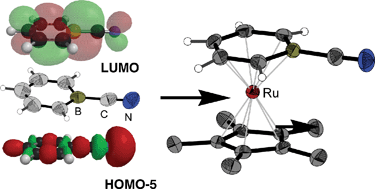 In this HOT article, Cade and Hill describe the synthesis of a salt of the 1-borabenzonitrile anion as its tetrabutylammonium salt and a preliminary exploration of its coordination chemistry in which it behaves as neither a conventional nitrile nor an isonitrile. The authors present computational, spectroscopic and crystallographic evidence for the heterocycle and a ruthenium complex containing the anion as an “arene” ligand.
In this HOT article, Cade and Hill describe the synthesis of a salt of the 1-borabenzonitrile anion as its tetrabutylammonium salt and a preliminary exploration of its coordination chemistry in which it behaves as neither a conventional nitrile nor an isonitrile. The authors present computational, spectroscopic and crystallographic evidence for the heterocycle and a ruthenium complex containing the anion as an “arene” ligand. A group of Spanish scientists have investigated the intramolecular [4C+3C] cycloaddition reaction of allenedienes in this Dalton Transactions Hot article.
A group of Spanish scientists have investigated the intramolecular [4C+3C] cycloaddition reaction of allenedienes in this Dalton Transactions Hot article.

![Molecular structure of [Ni6(O2CPh)6(6-mepao)6]](http://www.rsc.org/ej/DT/2011/c1dt10657k/c1dt10657k-f1.gif) Researchers from the University of Barcelona make discrete polynuclear metal complexes containing nickel in this Dalton Transactions Hot article.
Researchers from the University of Barcelona make discrete polynuclear metal complexes containing nickel in this Dalton Transactions Hot article.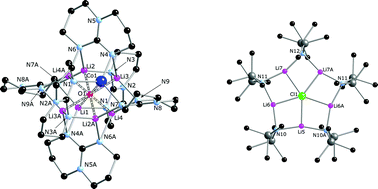 In this HOT article, Layfield and coworkers have studied the reactions of the heteroleptic lithium amide [Li3(μ-hmds)2(μ,μ-hpp)], where [hmds]– =
In this HOT article, Layfield and coworkers have studied the reactions of the heteroleptic lithium amide [Li3(μ-hmds)2(μ,μ-hpp)], where [hmds]– =